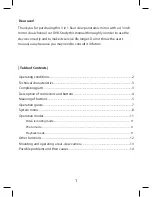
version 1.5 rev 4 Dec 2019
31
Sona &
Marana
4.6 s
oftWaRe
a
cqUisition
e
vents
Software Acquisition Events are only accessible via SDK - these are not available in Solis, Fusion, iQ or other software
but may be used internally. Refer to the SDK3 manual for further information on configuration of Software Acquisition
Events.
If Acquisition Events are not used, the user must wait until the image frame has been completely transferred to the
PC before they receive any notification that the exposure has completed. With Acquisition Events and in particular the
ExposureEndEvent the user will be notified as soon as the exposure is complete in advance of readout completion. This
in conjunction with SW trigger, means that the next acquisition can be started much sooner, resulting in an improvement
in frame rate.
4.7 R
olling
s
HUtteR
The Sona and Marana function in what is termed Rolling Shutter operation. This describes the sequence in which the
lines of the pixels are read from the sensor array in a “rolling wave” effect. In Rolling Shutter, adjacent rows of the array
are exposed at slightly different times as the readout waves sweep through the sensor. Each row will start and end its
exposure slightly offset in time from its neighbour. The rolling shutter readout mechanism is illustrated below.
Figure 6: Rolling Shutter Operation
•
At the start of an exposure, the “Reset” wave sweeps through the sensor clearing any accumulated charge from
the pixels. The pixels then start accumulating light induced charge.
•
At the end of the exposure, the “readout” wave sweeps through the sensor, transferring the charge from each
row into the readout node of each pixel.
So, whilst each row of pixels is exposed for exactly the same length of time they do not all start and end at exactly the
same time i.e. the row at the top edge of the sensor would have started and ended its exposure after the rows at the
bottom of the sensor.
Rolling shutter can be operated in a ‘continuous’ mode when capturing a kinetic series of images, whereby after each
row has been read out it immediately enters its next exposure. This ensures a 100% duty cycle, meaning that no time
is wasted between exposures and, perhaps more importantly, no photons are wasted. At the maximum frame rate for a
given readout speed the sensor is continuously reading out, so as soon as the readout fronts reach the top of the sensor,
they immediately return to the bottom to start readout of the next exposure.
Note: Rolling Shutter enables readout speeds to be maximised and the noise minimised - however a potential
complication of this readout type is spatial distortion. This was more commonly associated with older CMOS
Exposure Start
Exposure
Readout
















































